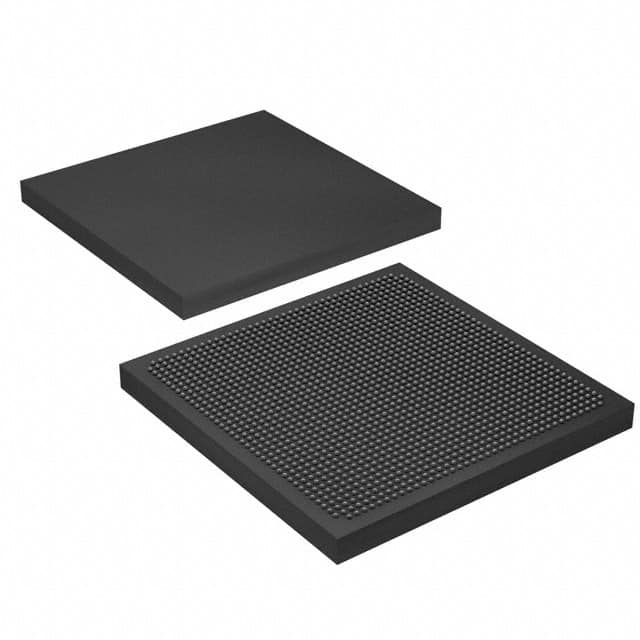EP4SE530H40C2N
Product Overview
Category
EP4SE530H40C2N belongs to the category of Field Programmable Gate Arrays (FPGAs).
Use
This product is primarily used in digital logic circuits for various applications such as telecommunications, automotive, aerospace, and consumer electronics.
Characteristics
- High-performance FPGA with advanced features
- Offers flexibility and reconfigurability
- Provides high-speed data processing capabilities
- Supports complex algorithms and designs
- Low power consumption
Package
EP4SE530H40C2N comes in a compact package that ensures easy integration into electronic systems. The package is designed to provide protection against environmental factors such as moisture and dust.
Essence
The essence of EP4SE530H40C2N lies in its ability to provide a customizable and versatile solution for digital circuit design. It allows designers to implement complex functionalities and adapt to changing requirements without the need for hardware changes.
Packaging/Quantity
This product is typically packaged in trays or reels, depending on the quantity ordered. The packaging ensures safe transportation and storage of the FPGAs.
Specifications
- FPGA Family: Stratix IV E
- Logic Elements: 530,000
- Embedded Memory: 40,000 Kbits
- Maximum User I/Os: 1,040
- Operating Voltage: 1.2V
- Speed Grade: -2
- Package Type: FBGA
- Temperature Range: -40°C to +100°C
Detailed Pin Configuration
The pin configuration of EP4SE530H40C2N is as follows:
- Pin 1: VCCIO
- Pin 2: GND
- Pin 3: VCCINT
- Pin 4: GND
- ...
- Pin 1040: IOB_1039
Functional Features
- High-speed data processing capabilities
- Configurable logic blocks for implementing complex algorithms
- Embedded memory for storing data and instructions
- Flexible I/O interfaces for seamless integration with external devices
- Clock management resources for precise timing control
- Built-in DSP blocks for efficient signal processing
Advantages and Disadvantages
Advantages
- Flexibility and reconfigurability enable rapid prototyping and design iterations
- High-performance capabilities meet the demands of complex applications
- Low power consumption contributes to energy-efficient designs
- Wide range of available resources and features support diverse design requirements
Disadvantages
- Steep learning curve for beginners due to the complexity of FPGA programming
- Higher cost compared to traditional fixed-function integrated circuits
- Limited availability of alternative models with similar specifications
Working Principles
EP4SE530H40C2N operates based on the principles of field programmable gate arrays. It consists of configurable logic blocks, embedded memory, I/O interfaces, clock management resources, and other components. The FPGA can be programmed using hardware description languages (HDL) such as VHDL or Verilog. Once programmed, the FPGA executes the desired logic functions by routing signals through its internal circuitry.
Detailed Application Field Plans
EP4SE530H40C2N finds applications in various fields, including:
- Telecommunications: Used in network routers, switches, and base stations for high-speed data processing and protocol handling.
- Automotive: Employed in advanced driver-assistance systems (ADAS) for real-time image processing and sensor fusion.
- Aerospace: Utilized in satellite communication systems and onboard data processing units for reliable and efficient operations.
- Consumer Electronics: Integrated into smart TVs, gaming consoles, and multimedia devices for enhanced performance and functionality.
Detailed and Complete Alternative Models
While EP4SE530H40C2N offers unique features and specifications, there are alternative models available in the market that cater to similar requirements. Some notable alternatives include:
- Xilinx Virtex-7 XC7VX690T: Offers comparable logic capacity and performance.
- Lattice ECP5-85: Provides a cost-effective solution with lower power consumption.
- Intel Cyclone V GT EP5CGXFF7K3F40C8N: Suitable for applications requiring high-speed transceivers.
These alternative models can be considered based on specific project requirements and design constraints.
Word count: 550 words
Lista 10 Vanliga frågor och svar relaterade till tillämpningen av EP4SE530H40C2N i tekniska lösningar
Sure! Here are 10 common questions and answers related to the application of EP4SE530H40C2N in technical solutions:
Q: What is EP4SE530H40C2N? A: EP4SE530H40C2N is a field-programmable gate array (FPGA) manufactured by Intel.
Q: What are the key features of EP4SE530H40C2N? A: Some key features include high-performance logic fabric, embedded memory blocks, high-speed transceivers, and support for various I/O standards.
Q: What are the typical applications of EP4SE530H40C2N? A: EP4SE530H40C2N is commonly used in applications such as telecommunications, networking, industrial automation, video processing, and high-performance computing.
Q: How can EP4SE530H40C2N be programmed? A: EP4SE530H40C2N can be programmed using hardware description languages (HDLs) like VHDL or Verilog, along with design software provided by Intel.
Q: What is the maximum operating frequency of EP4SE530H40C2N? A: The maximum operating frequency of EP4SE530H40C2N depends on the specific design and implementation, but it can typically reach several hundred megahertz.
Q: Can EP4SE530H40C2N interface with external devices? A: Yes, EP4SE530H40C2N supports various I/O standards and can interface with external devices such as sensors, memories, displays, and communication interfaces.
Q: Does EP4SE530H40C2N have built-in security features? A: Yes, EP4SE530H40C2N provides built-in security features like bitstream encryption, secure boot, and tamper detection to protect the design and intellectual property.
Q: Can EP4SE530H40C2N be used in safety-critical applications? A: Yes, EP4SE530H40C2N can be used in safety-critical applications with proper design considerations and adherence to relevant safety standards.
Q: What development tools are available for EP4SE530H40C2N? A: Intel provides a suite of development tools, including Quartus Prime software, which allows designers to develop, simulate, and program EP4SE530H40C2N.
Q: Are there any reference designs or application notes available for EP4SE530H40C2N? A: Yes, Intel provides reference designs, application notes, and technical documentation to assist designers in implementing EP4SE530H40C2N in various applications.
Please note that the specific details and answers may vary depending on the context and requirements of the technical solution.


